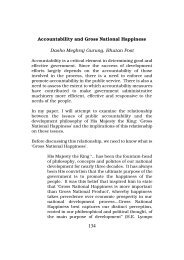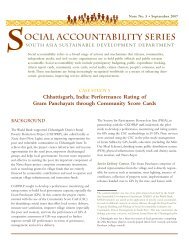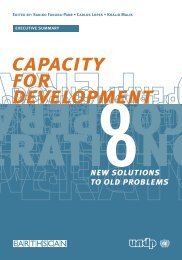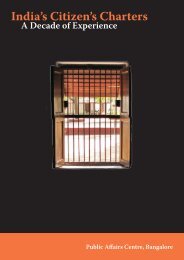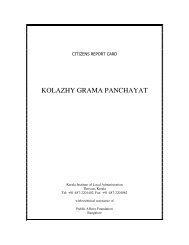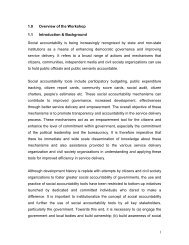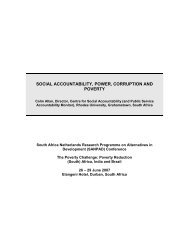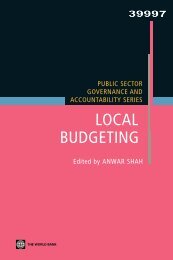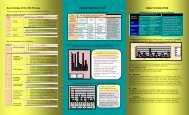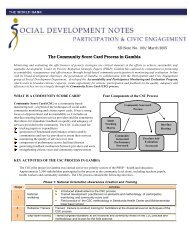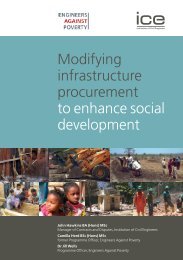Enabling Environment for Social Accountability in ... - SASANet
Enabling Environment for Social Accountability in ... - SASANet
Enabling Environment for Social Accountability in ... - SASANet
You also want an ePaper? Increase the reach of your titles
YUMPU automatically turns print PDFs into web optimized ePapers that Google loves.
Annex 4. <strong>Social</strong> <strong>Accountability</strong> and Service Delivery:<br />
Community Involvement <strong>in</strong> Mongolian Schools 78<br />
One of the more positive legacies of Mongolia’s socialist past is its high level of literacy, which rema<strong>in</strong>s<br />
at 98 percent despite a relatively high level of poverty. Primary school enrollment has also been susta<strong>in</strong>ed<br />
at a nearly universal rate. However, secondary school enrollment dropped dramatically <strong>in</strong> the mid-1990s,<br />
but recovered to more than 93 percent by academic year 2004–05 (United Nations Statistical Yearbook<br />
2004). 79 Although public expenditure on education has been higher than <strong>in</strong> most transition countries, total<br />
spend<strong>in</strong>g has fallen and rema<strong>in</strong>s below the 1990 level of 12 percent of GDP, decl<strong>in</strong><strong>in</strong>g to 5.5 percent <strong>in</strong><br />
1995 be<strong>for</strong>e gradually <strong>in</strong>creas<strong>in</strong>g to 9 percent by 2002 (Dung et al. 2006). Stakeholders nevertheless<br />
<strong>in</strong>dicate that education rema<strong>in</strong>s a high priority. In the op<strong>in</strong>ion poll conducted <strong>in</strong> May 2005, nearly onequarter<br />
of the respondents said that education was their highest priority, although only 40 percent thought<br />
that public officials were provid<strong>in</strong>g sufficient access to education, and 23 percent <strong>in</strong>dicated that they were<br />
able to ensure the quality of education (annex 7, Questions C and K).<br />
This case study on community <strong>in</strong>volvement <strong>in</strong> k<strong>in</strong>dergarten through secondary school is based largely on<br />
data collected at two public schools, one <strong>in</strong> Ulaanbaatar and the other <strong>in</strong> Uyanga soum, Uvorkhangai<br />
aimag, <strong>in</strong> central Mongolia. Interviews were held with stakeholders at the national and local levels,<br />
<strong>in</strong>clud<strong>in</strong>g representatives of the M<strong>in</strong>istry of Education, Culture and Science (MoECS), local government<br />
officials, parents, and leaders of education-related NGOs. Whereas the schools were chosen to provide<br />
both an urban and a rural perspective, the school <strong>in</strong> Ulaanbaatar was selected <strong>for</strong> its location along the<br />
“border” between the city center and the Ger District, which is composed largely of recent migrants. 80<br />
Although it is difficult to draw general conclusions about the Mongolian education system from just two<br />
examples, the case study provides <strong>in</strong>sights <strong>in</strong>to issues related to social accountability <strong>in</strong> the education<br />
sector.<br />
Over the last decade, the MOECS’ re<strong>for</strong>ms have vary<strong>in</strong>gly supported and underm<strong>in</strong>ed civic engagement<br />
and social accountability <strong>in</strong> Mongolia’s education sector. Although re<strong>for</strong>ms were <strong>in</strong>tended to ensure local<br />
<strong>in</strong>put <strong>in</strong>to the management of public schools, it has been difficult to achieve the appropriate balance<br />
between community <strong>in</strong>volvement through the school boards and stability <strong>in</strong> the management of public<br />
schools. As a result, effective participation of parents and the broader community <strong>in</strong> the education sector<br />
appears weak. The need <strong>for</strong> community <strong>in</strong>volvement <strong>in</strong> schools is illustrated by concerns about<br />
mismanagement of funds and allegations of corruption <strong>in</strong> the private tutor<strong>in</strong>g by public school teachers.<br />
LOCAL PARTICIPATION IN PUBLIC SERVICE DELIVERY:<br />
FROM SCHOOL BOARDS TO SCHOOL COUNCILS<br />
In 1995, the State Great Khural passed a new Law on Education that established local School Boards <strong>for</strong><br />
preschool, primary, and secondary schools. Pursuant to Article 30 of the Law, the Boards were given a<br />
78 Research <strong>for</strong> this case study was conducted primarily by Alison Dong, a graduate student at Teacher’s College, Columbia<br />
University and Bilge Byambaa, a consult with The Asia Foundation. with guidance from Charles Abelmann (Lead Program<br />
Coord<strong>in</strong>ator, World Bank).<br />
79 An OSF education program officer noted that GoM statistics tend not to <strong>in</strong>clude disabled children, mostly mentally but often<br />
physically disabled, who are not enrolled <strong>in</strong> school.<br />
80 Gers are traditional tents commonly used <strong>in</strong> rural Mongolia and <strong>in</strong>creas<strong>in</strong>gly by migrants whose gers circle much of the<br />
perimeter of Ulaanbaatar. In the Ger district as well as the countryside, household <strong>in</strong>comes tend to be lower and social services,<br />
less accessible.




